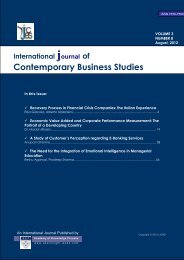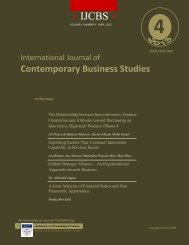Contemporary Business Studies - Academy of Knowledge Process ...
Contemporary Business Studies - Academy of Knowledge Process ...
Contemporary Business Studies - Academy of Knowledge Process ...
You also want an ePaper? Increase the reach of your titles
YUMPU automatically turns print PDFs into web optimized ePapers that Google loves.
International Journal <strong>of</strong> <strong>Contemporary</strong> <strong>Business</strong> <strong>Studies</strong><br />
Vol: 3, No: 1. January, 2012 ISSN 2156-7506<br />
Available online at http://www.akpinsight.webs.com<br />
compress lead times, adapt to unanticipated changes in demand, and to cope with environmental<br />
uncertainty in the marketplace. However, the interdependencies created among participating organizations<br />
via integrated supply networks make them more vulnerable to supply chain disruptions, thus increasing<br />
risks.<br />
3. SUPPLY CHAIN RISKS<br />
Spekman and Davis (2004) define risk as the probability <strong>of</strong> variance in an expected outcome. Therefore, it<br />
is possible to quantify risk because it is possible to assign probability estimates to these outcomes (Khan<br />
and Burnes, 2007). On the contrary, uncertainty is not quantifiable and the probabilities <strong>of</strong> the possible<br />
outcomes are not known (Knight, 1921). A joint evaluation <strong>of</strong> risk and uncertainty conducted by Yates<br />
and Stone (1992) suggests that risk implies the existence <strong>of</strong> uncertainty associated with a given outcome,<br />
because if the probability <strong>of</strong> an outcome is known, there is no unknown risk. Thus, uncertainty can be<br />
regarded as a key determinant <strong>of</strong> risk that may not be entirely eradicated, but can be mitigated through the<br />
deployment <strong>of</strong> risk reduction action steps (Slack and Lewis, 2001). In business situations, managers are<br />
expected to reduce the organization’s exposure to uncertainty through the deployment <strong>of</strong> effective risk<br />
management strategies.<br />
Internal and external uncertainties both provide sources for supply chain risks (Cucchiella and Gastaldi,<br />
2006). Changes in capacity availability, interruptions in information flows, and reductions in operational<br />
efficiencies are all possible sources <strong>of</strong> internal uncertainty. External sources <strong>of</strong> uncertainty leading to<br />
increased supply chain risks include the actions <strong>of</strong> competitors, price fluctuations, changes in the political<br />
environment, and variations in supplier quality. These sources <strong>of</strong> uncertainty can be considered ‘risk<br />
events’ that can lead to supply chain disruptions that inhibit performance. Thus, it is necessary for<br />
managers to first understand the various categories <strong>of</strong> risks along with the events and conditions that drive<br />
them before they attempt to devise approaches to reduce supply chain risks (Chopra and Sodhi, 2004).<br />
The research literature <strong>of</strong>fers a variety <strong>of</strong> approaches for categorizing risks in supply chain networks. For<br />
example, Treleven and Schweikhart (1988) have classified supply chain risk events based upon their<br />
association with the following: supply chain disruptions, price fluctuations, inventory and scheduling<br />
changes, technology advancements, and quality issues. Kleindorfer and Wassenhove (2003) designated<br />
supply chain co-ordination and supply disruptions as categories <strong>of</strong> supply chain risks, and Zsidisin (2003)<br />
defined supply risk as the probability <strong>of</strong> an incident associated with failures in the inbound supply from<br />
individual suppliers or the supply market, which results in the inability <strong>of</strong> the purchasing firm to meet<br />
customer demand or causes threats to customer life and safety. Paulsson (2004) classified supply chain<br />
risks as operational disturbances, tactical disruptions, and strategic uncertainties. Giunipero and Eltantawy<br />
(2004) categorized these risks based upon conditions that result in their creation, such as political events,<br />
product availability, transportation distances, changes in technology and labor markets, financial<br />
instability, and management turnover. Supply chain disruptions, delays, systems, forecasts, intellectual<br />
property, procurement, receivables, inventory, and capacity are classifications for supply chain risks<br />
<strong>of</strong>fered by Chopra and Sodhi (2004).<br />
Several researchers have chosen to categorize supply chain risks in the following manner: demand-side<br />
risks resulting from disruptions emerging from downstream supply chain operations (Suttner, 2005);<br />
supply-side risks residing in purchasing, supplier activities, and supplier relationships (Wu et al, 2006);<br />
and catastrophic risks that, when they materialize, have a severe impact in terms <strong>of</strong> magnitude in the area<br />
<strong>of</strong> their occurrence (Wagner and Bode, 2006). Nagurney et al (2005) define demand side risk as the<br />
uncertainty surrounding the random demands that <strong>of</strong>ten occur at the retailer stage <strong>of</strong> the supply chain. Wu<br />
et al (2006) state that inbound supply risk is defined as the potential occurrence <strong>of</strong> an incident associated<br />
with inbound supply from individual supplier failures or the supply market. This results in the inability <strong>of</strong><br />
8<br />
Copyright © 2012. <strong>Academy</strong> <strong>of</strong> <strong>Knowledge</strong> <strong>Process</strong>
















